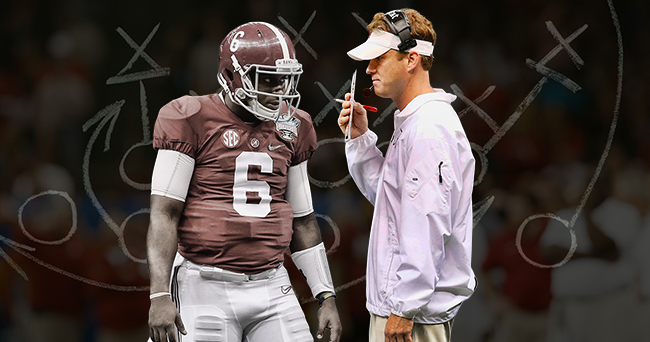Looking back at Lane Kiffin's Sugar Bowl play-calling
No hire in college football last year made waves like Lane Kiffin being brought on as Alabama’s offensive coordinator. People around the country and the SEC were scratching their heads wondering why Nick Saban would take a chance on the controversial coach and whether Kiffin’s style and personality would mesh with Alabama.
Those critics were silenced all season, as Alabama’s prolific offense scored points and broke records in bunches, but the criticism came back to the surface when Alabama crumbled in its Sugar Bowl loss to Ohio State.
Alabama’s offense looked lost for stretches of the game, never more so than on the final, unhurried 93-second drive that ended in Blake Sims’ tossing a 42-yard heave into the end zone. Here’s how that drive went:
- 1st-and-10: Blakes Sims throws out route to O.J. Howard for six yards, tackled in bounds.
- 2nd-and-4 (22 seconds elapsed): Sims throws crossing route to Chris Black for two yards, tackled in bounds.
- 3rd-and-2 (24 seconds elapsed): Sims throws short post to DeAndrew White for 12 yards, tackled in bounds.
- 1st-and-10 (14 seconds elapsed): Sims scrambles for 12 yards, slides down in bounds.
- 1st-and-10 (14 seconds elapsed): Sims throws out route to Howard for eight yards, runs out of bounds.
- 2nd-and-2 (5 seconds elapsed): Sims throws incomplete to White deep down left sideline.
- 3rd-and-2 (7 seconds elapsed): Sims throws Hail Mary to end zone toward Amari Cooper and Black, Ohio State intercepts pass.
The amount of time between plays is troubling. Alabama used up almost half of its available clock on the first two plays alone, and both plays were troubling. Both passes were thrown to the middle of the field, and after the first pass to Howard it appeared the Crimson Tide did not have a second play ready, as most teams do on a last-minute drive; instead of getting straight to the line, the Alabama offense turned to look at Sims, who had to look to the sideline for a play.
That lack of urgency has to trace back to Kiffin. As good as Sims was all year, he was not the play-caller; that would be Kiffin. The coach should have relayed two plays to Sims before the Alabama offense headed onto the field for its final drive, especially knowing it had no timeouts left.
The second issue: where was Alabama’s best receiver, Cooper? Throughout the Sugar Bowl, Ohio State did a phenomenal job of taking away what Cooper does well by playing him tight at the line and shading safeties his way, denying the bubble screens and short passes that Cooper and Alabama have thrived on. On the final drive, though, Sims didn’t even look Cooper’s way on three of the pass attempts. For Kiffin, known as a genius play-caller, not being able to get Cooper open on the most important drive of the season is a failure.
Kiffin had done a remarkable job of doing that all season, but it didn’t appear the Heisman finalist one of Sims’ first two reads on several of the end-game pass attempts. While Cooper was targeted 11 times in the Sugar Bowl, his impact was mostly negated by Ohio State’s tight coverage. The Buckeyes shaded their defensive coverage toward Cooper, seemingly daring Alabama to run the ball.
That leads to the next issue with the game Kiffin called. In his Broyles Award banquet speech, Kiffin joked that Nick Saban pleads with him on the sideline to run the ball. Saban perhaps should have been a bit more forceful with those requests in New Orleans.
Sims attempted 36 passes in the Sugar Bowl, his second-most attempts for the year. Typically, Alabama’s offense suffered when it couldn’t run the ball. Against Ohio State, the Tide had no problem doing that, as they averaged five yards per carry. The head-scratching part was that the Tide didn’t feed the player that racked up the majority of their yards.
Derrick Henry piled up 95 of Alabama’s 170 rushing yards, averaging 7.3 yards per carry, but he didn’t see near enough of the ball. With T.J. Yeldon banged up, reason stood that it would be Henry handling the majority of the running duties. Instead, he had 13 carries, just three more than the hobbled Yeldon’s 10. Sims had another 10 carries, although they came mostly on scrambles and broken plays, not designed runs. That left Alabama with just 23 running back carries, a paltry number for a team that showed it was more than capable of running on an Ohio State defense that was practically begging it to do so.
For whatever reason, Kiffin didn’t put the ball in his beast’s hands. On Alabama’s second touchdown drive, Henry carried the ball four times for 30 yards. That drive ended with 2:06 remaining in the first quarter. Henry wouldn’t see the ball again until there were less than six minutes to go in the third. In that gap, Alabama only ran the ball four times and had two three-and-out series.
That pass-happy offense was part of what helped to doom the Crimson Tide in the Sugar Bowl. Of Alabama’s 11 failed third-down conversions, seven of them came on designed pass plays, including the final play of the game, despite more than half of those failed third downs coming with five or fewer yards to go.
Alabama used the run plenty this year; it’s not as if Kiffin completely veered away from the strength of the offense from the previous several years. But in big moments, he got away from a balanced offense, like when he took to the air against LSU and when his team couldn’t run against Arkansas.
Kiffin’s first year in Tuscaloosa was undoubtedly successful. His first bowl game with the team was not. Will he learn from his mistakes this time around?

